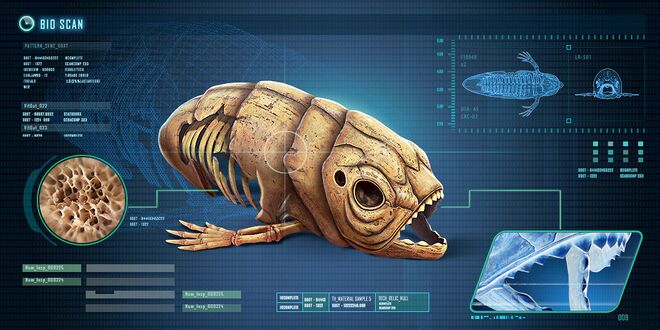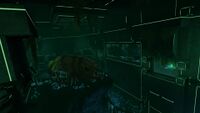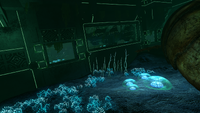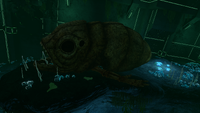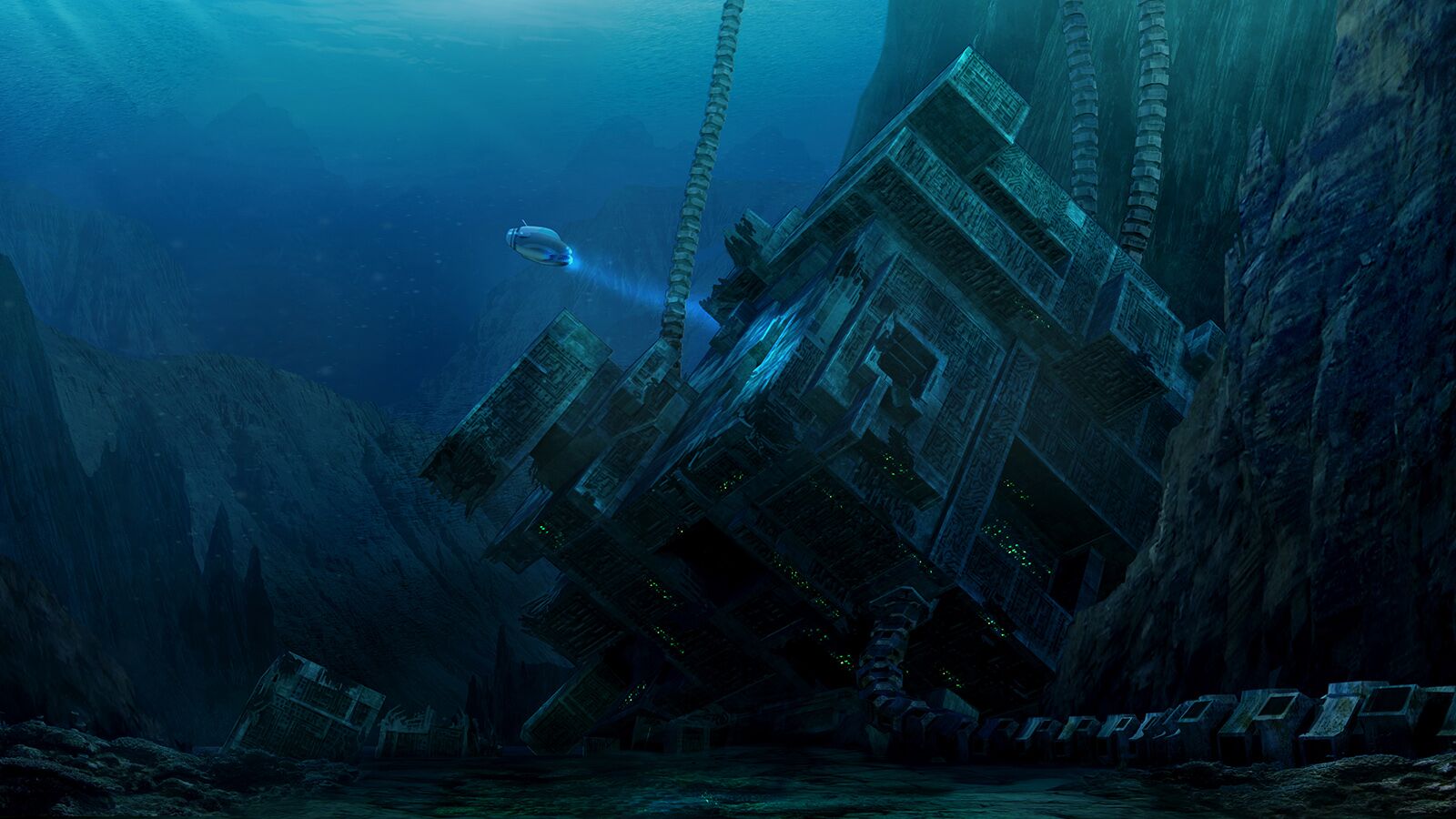Research Specimen: Difference between revisions
GemmaBeepo (talk | contribs) m (GemmaBeepo moved page Research Specimen Theta to Research Specimen: whoops) |
GemmaBeepo (talk | contribs) No edit summary Tag: 2017 source edit |
||
| Line 17: | Line 17: | ||
|length = 21 meters |
|length = 21 meters |
||
}} |
}} |
||
'''Research Specimen |
'''Research Specimen''' was an individual of a large predatory species kept in the main aquarium of the [[Disease Research Facility]] for a long period of time for testing purposes. |
||
This specimen is distantly related to five species still living on the planet today; the PDA notes shared skeletal traits with the [[Biter]] and [[Sand Shark]], by extension this also makes '''Research Specimen Theta''' a relative of the [[Boneshark]] and [[Blighter]], and a very distant relative of the [[Rockgrub]]. |
This specimen is distantly related to five species still living on the planet today; the PDA notes shared skeletal traits with the [[Biter]] and [[Sand Shark]], by extension this also makes '''Research Specimen Theta''' a relative of the [[Boneshark]] and [[Blighter]], and a very distant relative of the [[Rockgrub]]. |
||
== Data Bank Entry == |
== Data Bank Entry == |
||
<tabber> |
|||
Remains of Research Specimen= |
|||
{| class="article-table" style="width:100%; border:0; border-spacing:0" |
{| class="article-table" style="width:100%; border:0; border-spacing:0" |
||
|- |
|- |
||
| Line 37: | Line 35: | ||
While it shares some skeletal traits with the biter and sand shark, including its distinctive double eye sockets, this fossilized specimen is significantly larger, and features unusual forearms rarely seen in aquatic species. This species has likely gone extinct in the past thousand years, and its evolutionary relatives have evolved almost beyond recognition. |
While it shares some skeletal traits with the biter and sand shark, including its distinctive double eye sockets, this fossilized specimen is significantly larger, and features unusual forearms rarely seen in aquatic species. This species has likely gone extinct in the past thousand years, and its evolutionary relatives have evolved almost beyond recognition. |
||
|} |
|} |
||
|-| |
|||
Specimen Research Data= |
|||
{| class="article-table" style="width:100%; border:0; border-spacing:0" |
|||
|- |
|||
! style="width:100%; text-align:center" | |
|||
|- |
|||
| style="text-align:left; font-size:12px;" | |
|||
A catalog of information on the organisms previously contained within the alien facility. A number of entries have been translated. |
|||
Small Herbivore Gamma:<br/> |
|||
This entry seems to reference the common peeper. Shows no immunity to infection - death commonly occurs within 4 days. Shows symptom remission on exposure to Enzyme 42, but symptoms quickly recur. Shows advanced learning behaviors. Shows some capacity to transmit enzymes to other specimens. |
|||
Leviathan Embryos:<br/> |
|||
Adult specimen too large to study in containment. Egg specimens acquired from nesting site. Embryos show no signs of immunity - death commonly occurs within 3 weeks. Small sample of eggs has been retained for continued, high priority research on leviathan hatching mechanisms. |
|||
'''Large Carnivore Theta:'''<br/> |
|||
'''Off-site lab established to study remains. Shows some potential for immunity to infection, but physical remains so far proved insufficient for full reconstruction.''' |
|||
Unidentified Leviathan:<br/> |
|||
This leviathan species has been assigned designator 'Sea Emperor'. Bone samples from emperor specimens indicate some potential for kharaa immunity. Single specimen captured for study at purpose-built containment facility, constructed in volcanic region at depth 1.4km. |
|||
Assessment: While it is unlikely that the emperor specimen is still contained within the facility described, it may be possible to acquire further data there on the aliens' attempts to develop a vaccine. |
|||
|} |
|||
</tabber> |
|||
== Gallery == |
== Gallery == |
||
| Line 66: | Line 40: | ||
In-Game= |
In-Game= |
||
<gallery widths="200" spacing="small" navigation="true"> |
<gallery widths="200" spacing="small" navigation="true"> |
||
DRF24.jpg|Research Specimen in the Disease Research Facility |
DRF24.jpg|The Research Specimen in the Disease Research Facility |
||
Aquarium2.png|A view from behind |
Aquarium2.png|A view from behind |
||
Aqauriumcreature.png|A close-up of |
Aqauriumcreature.png|A close-up view of the remains |
||
</gallery> |
</gallery> |
||
|-| |
|-| |
||
Revision as of 10:42, 27 October 2024

|
Read at own risk This article contains unmarked spoilers. Players new to the game would want to avoid or be cautious toward this article. |
<infobox layout="stacked">
<title source="title" style="font-weight:bold; text-align:center;"> <default>Research Specimen</default> </title> <image source="image">
</image> <label>Age</label> <label>Status</label> <label>Biome</label> <label>Length</label> <label>Coordinates</label> <label>GoTo</label> <label>Debug Spawn</label> </infobox> Research Specimen was an individual of a large predatory species kept in the main aquarium of the Disease Research Facility for a long period of time for testing purposes. This specimen is distantly related to five species still living on the planet today; the PDA notes shared skeletal traits with the Biter and Sand Shark, by extension this also makes Research Specimen Theta a relative of the Boneshark and Blighter, and a very distant relative of the Rockgrub.
Data Bank Entry
|
The skeletal remains of a vast predator, housed within an artificial habitat. 1. Habitat: 2. Evolution: |
Gallery
<tabber> In-Game=
|-| Models=
</tabber>
Lua error in package.lua at line 80: module 'Dev:Navbox' not found.

